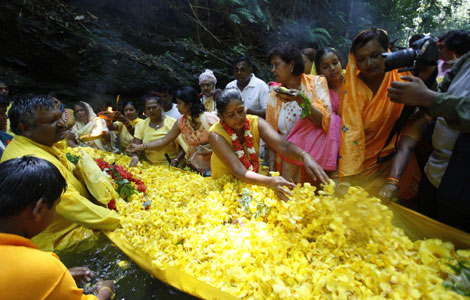Site provides clearer picture of China's past
Updated: 2013-05-17 08:31
By Yan Yiqi in Hangzhou (China Daily)
|
||||||||
New archaeological discoveries in Yuyao city, in eastern China's Zhejiang province, provide a clearer picture of life in China's Neolithic age and confirm that the nation originated the practice of paddy cultivation.
Archaeologists are completing a 10-year dig in Tianluo Mountain, which demonstrates a clear layout of typical Neolithic tribes, Sun Guoping, captain of the exploration team, told China Daily on Tuesday.
"It is so far the best preserved site of the Hemudu culture," he said, referring to one of the cradles of Chinese civilization.
"We can see a clear wooden structure of the living and working areas of a tribe. There were walls, food stores, paddy fields and even piles of rice husks."
The Hemudu site recorded primitive activities of ancient China from 7000-5000 BC, one of the earliest recordings of China's Neolithic age. Archaeological exploration of the site began in 1973.
Discoveries at the Tianluo Mountain site prove that the practice of cultivating paddy started in China, Sun said.
He said the site covers an area of more than 30,000 square meters with six layers. Some 1,800 sq m of land has been explored during the past 10 years of exploration, and more than 7,000 relics have been discovered.
Yao Xiaoqiang, deputy curator of the Hemudu Cultural Site Museum, said that the Tianluo Mountain site had well-preserved paddy fields from the early and late Hemudu period.
"The relics had recorded the developing process of the earliest agricultural activities in the world. You can see the complete layout of primitive paddy fields, which is of great research value," Yao said.
Many of the discoveries were the first of their kind in 40 years' exploration of Hemudu culture, he said.
Ancient ladders made from a single piece of wood, big houses for ritual activities, wood-carved ritual wares with birds, and wooden swords allowed people to imagine what lives were like more than 7,000 years ago.
"The ritual houses and wares proved that people at that period had certain kinds of beliefs, while the food stores told us what they ate," said Yao.
The Tianluo Mountain site was accidentally discovered in 2001 by locals who were trying to drill a well. Sun and his team judged that it might be a well-preserved relic of the Neolithic age. After three years' research and preparation, exploration of the site officially started in 2004.
To better protect the site, the local government spent more than 10 million yuan ($1.6 million) to build a 4,000 sq m shelter above it. The shelter has been open to tourists since 2007.
Sun said that after 10 years' exploration, the discoveries and achievements have been fruitful, and since the relics need further protection, the exploration will end by June.
The team will then focus on sorting and studying the findings, and protecting the relics.
yanyiqi@chinadaily.com.cn
(China Daily 05/17/2013 page7)

 Michelle lays roses at site along Berlin Wall
Michelle lays roses at site along Berlin Wall
 Historic space lecture in Tiangong-1 commences
Historic space lecture in Tiangong-1 commences
 'Sopranos' Star James Gandolfini dead at 51
'Sopranos' Star James Gandolfini dead at 51
 UN: Number of refugees hits 18-year high
UN: Number of refugees hits 18-year high
 Slide: Jet exercises from aircraft carrier
Slide: Jet exercises from aircraft carrier
 Talks establish fishery hotline
Talks establish fishery hotline
 Foreign buyers eye Chinese drones
Foreign buyers eye Chinese drones
 UN chief hails China's peacekeepers
UN chief hails China's peacekeepers
Most Viewed
Editor's Picks

|

|

|

|

|

|
Today's Top News
Shenzhou X astronaut gives lecture today
US told to reassess duties on Chinese paper
Chinese seek greater share of satellite market
Russia rejects Obama's nuke cut proposal
US immigration bill sees Senate breakthrough
Brazilian cities revoke fare hikes
Moody's warns on China's local govt debt
Air quality in major cities drops in May
US Weekly

|

|







